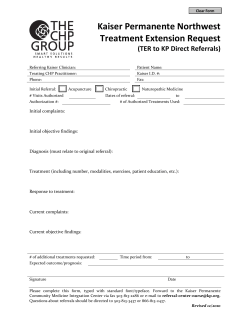
2. Antimicrobials - Green Science Policy Institute
Six Classes We can reduce harmful chemicals for a healthier world. Periodic table of elements Halogens 2 9 F 17 Cl 35 Br Six classes 1. Highly fluorinated chemicals water and oil repellants, surfactants… 2. Antimicrobials triclosan, triclocarban… 3. Flame retardants brominated, chlorinated, phosphate 4. Bisphenols and phthalates plastic additives… 5. Organic solvents benzene, methylene chloride... 6. Certain metals lead, mercury, chromium, cadmium, arsenic… 3 Six Classes 2. Antimicrobials: Triclosan and Triclocarban Gary Ginsberg PhD Connecticut Department of Public Health, Yale & U. Connecticut 4 Main Concerns Cl • Toxic Properties • Widespread Exposure O Cl – common in personal care products • Vulnerable receptors (young childen) OH Cl Triclosan 0.3-0.5% Cl Cl O Cl N H N H Triclocarban 0.6-1.5% 5 Where they are used • Disinfectant in hospitals • Increasing use in consumer products – Hand soaps, lotions, mouthwash, detergent, shampoo • Must be listed - regulated by FDA as over-the-counter drugs – – – – – Deodorant/clothing – reduce odors Toothpaste – reduce plaque & gum disease Cosmetics Kitchen supplies, furniture Toys, school supplies, sports equipment Rapid uptake during a short shower 90 Human pharmacokinetics following dermal exposure from lather 250 70 200 60 50 150 40 100 30 TCC in whole blood (nM) TCC in whole blood (ng/mL) 80 20 50 10 0 0 0 20 40 60 80 100 Time after dermal exposure (hr) Schebb et al. ES&T 45: 3109-3115,2011 120 7 Persistent Organochlorines Triclocarban Alternatives (Simpler, No Chlorine) Ethyl Alcohol Triclosan Isopropyl Alcohol 2,3,7,8-TCDD (dioxin) Hydrogen Peroxide 8 Endocrine Disruption • Thyroid-blocking – Alters metabolism & transport of thyroid hormone • Estrogen-enhancing – Synergizes estrogen action • Testosterone-blocking – Decreases testosterone & sperm production 9 Increased Allergy in Children • Triclosan associated with increased sensitivity to common airway allergens in children – e.g. mold, animal dander (Bertelsen et al. 2013) • Two possible mechanisms – Antibacterials remove “healthy” bacteria – Triclosan stimulates allergic response • mouse model of asthma 10 Range of Human Exposure What do the Exposure Levels Found in Humans Mean? 100 µg/kg/d Toxic effects on blood and g.i. tract Anti-Thyroid effect Estrogen enhancing effect in rats 10 µg/kg/d Upstream biochemical effects Increased allergy in children 1 µg/kg/d No effects known in children so far 11 Environmental Issues • Exposures – 10-20 million lbs/yr - 95% goes down the drain – Wastewater treatment plants “degrade” only 60-80% • Impacts – Persistent in environment – sediment/water – Concerns wastewater treatment plant • Endocrine disruption and toxicity (Fish/Amphibians/Algae) • Effect on biological wastewater treatment processes safely • Possible increase in resistant bacteria degraded 12 Do We Need Them? • Do they provide a benefit? • No proven benefit over hand washing with soap and water • Potential to breed resistant bacteria • Food industry? • Research: Ineffective in flooring and plastic • In toothpaste? • Oral disease prevention comes first • Ask dentist if antibacterial product is needed • NO EVIDENCE ANTIMICROBIALS CUT DOWN ON INFECTIONS AROUND THE HOME 13 Alternative to triclosan-embedded cutting board: 2 cutting boards vs Mayo Clinic Statement “There's no evidence that cutting boards containing triclosan, an antibacterial agent, prevent the spread of food-borne infections. These boards also may give a false sense of security and cause you to relax other efforts to keep the board clean. In addition, triclosantreated boards don't kill germs.” 14 Kaiser Permanente Pullback • • • • Triclosan not used in its 37 hospitals since 2010 Precautionary approach to safety Replaced by other disinfectants, soap/water Kaiser action shows triclosan not needed, even in hospital “If there is credible evidence that a product we're using might have some disadvantages from a health or environmental standpoint, then it's our obligation to look for a safer alternative” -Kathy Gerwig, Kaiser Permanente VP 15 Policy Actions • EU 2011 – Concern for effect of cumulative exposure – Concern for use in food contact materials • FDA 2012 – Not known to be hazardous to human health – Under review for endocrine disruption & bacterial resistance • EPA 2013 – Major review initiated for endocrine disruption • Manufacturer pullbacks announced 2013 2015 (triclosan, phalates, parabens, formaldehyde, 1,4-dioxane) 2014 (triclosan and phthalates) 16 Take away points • Is it Toxic: YES – Endocrine disruption and immune effects at relevant doses – May lead to more asthma and resistant bacteria • Is it Necessary: Most uses – NO – Other ways to control bacteria • Are Regulators Concerned: YES – studying the matter • Are Manufacturers Concerned: YES – Certain producers/hospitals – pulling back • How can Triclosan be avoided? – Avoid products w/triclosan on the label – Do not give children adult toothpaste 17 Follow-up questions • Are there anti-microbials in the products you manufacture, sell, or use? • What functions do they serve? • How necessary are these functions? • What alternatives have you investigated? • Would you be interested in continuing this discussion? If so, contact: Erika Houtz, Erika@GreenSciencePolicy.org 18
© Copyright 2025









